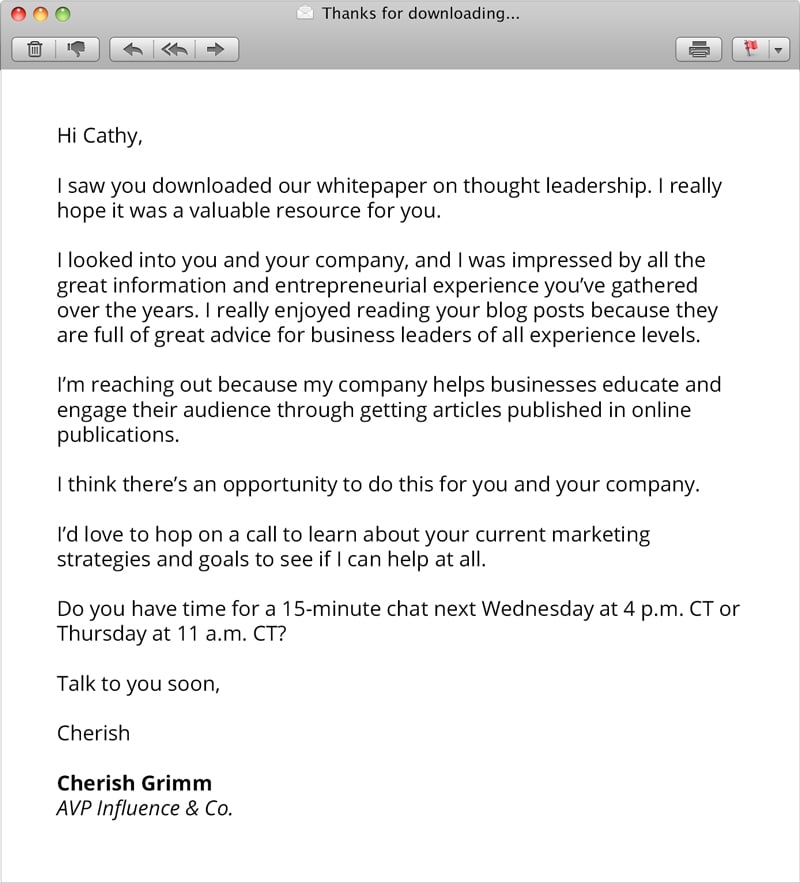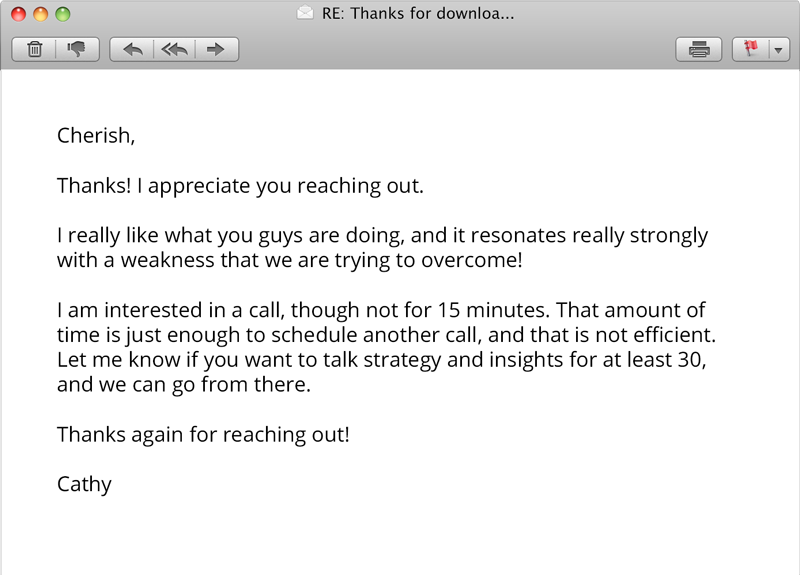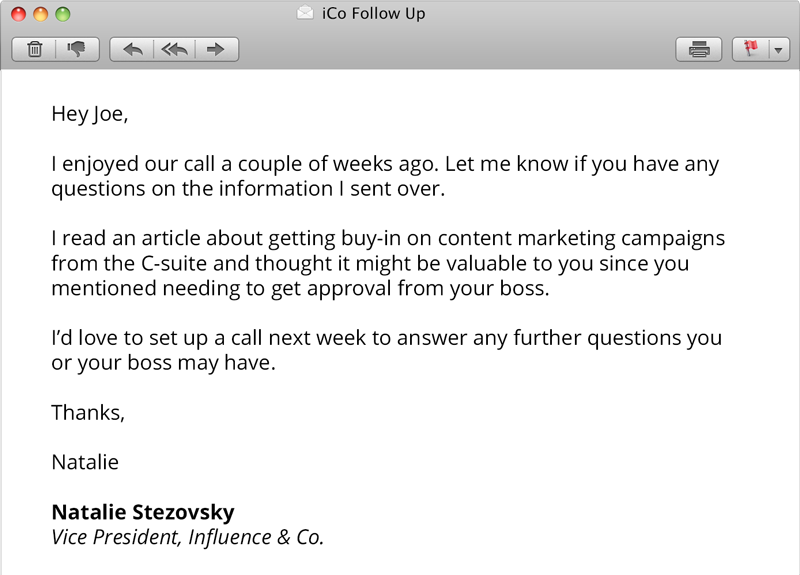
During a recent conversation, a prospective client made a statement that struck a chord with me. He said, “I understand the importance of thought leadership content coming from our brand, but I am just uncomfortable being the front person. You see, Kels, I just don’t have a huge ego.”
I immediately wanted to send him the insightful article my team member, Ryan O’Connell, wrote on why being a thought leader isn’t about your ego. It made me realize that for the types of clients we want — people who can put their egos aside and truly strive to educate and engage an audience — this could be an ongoing internal struggle.
I get it. Honestly, I sometimes feel strange tweeting my own articles or writing an article for our blog about how my last article helped our company.
When you’re part of an awesome organization, you want to showcase the brand. But people generally don’t trust brands; they trust and relate to the individuals behind them. Following this notion, you can use your individual voice to draw in your company’s ideal clients, close more sales, recruit top talent, and educate your team.
Leverage Thought Leadership for Company Culture/Recruitment
People want to work for the best, and they want to be able to relate to the people they work with.  Tweet this When leaders share their ideas and expertise through written content, they are building trust, excitement, and pride within the organization.
Tweet this When leaders share their ideas and expertise through written content, they are building trust, excitement, and pride within the organization.
Rand Fishkin, founder of Moz, is a great example of how producing valuable content can perpetuate company pride. He writes a blog, does Whiteboard Fridays, and has become a thought leader in search and online marketing.
Rand’s content not only informs his audience about lead generation and brand awareness, but it also educates and engages Moz employees. They share his content on a regular basis, which shows they enjoy working for someone who inspires and educates.
Check out his latest Whiteboard Friday on branded searches:
Employees feel great pride when they see their leaders sharing their expertise. In response to Chimaeric CEO David Anderson’s interview on IdeaMensch, his team members shared positive responses on social media, including the one below.

Potential employees should be reading your content, too. Utilizing content in the recruitment process allows you to sift through people who wouldn't be a good culture fit, dig deeper into interview questions, and find better talent.
At Influence & Co., we use content to enhance the recruitment process in the following ways:
- We include articles about our company culture in our job descriptions. This allows people to read about things like our douchebag jar and WWE Championship belt. If they’re freaked out by our unique culture, they won’t apply, and we’re fine with that because it probably wouldn’t have been a good long-term fit.
- When we schedule an interview, we send over more articles about our culture and the industry as a whole. This gives the interviewee homework and can tell us whether the person is committed and excited to work for our company.
- We can ask deeper questions during the interview process. We know potential employees have a basic understanding of the industry, and familiarizing them with our content before the interview allows us to focus on interview questions that really matter.
- When we interview amazing candidates but don’t have an open position, we put them on a drip campaign. We continuously inform them about news within our industry and our company. This keeps them familiar with what we do (and what interested them in the first place). When a position opens up down the road, we will be top of mind.
Thought leadership allows you to educate all of your audiences; sometimes, a leader’s most important audience is the people he or she is responsible for teaching, motivating, and guiding. It’s not about your ego; it’s about rallying excitement and engagement across the entire company.  Tweet this
Tweet this
Leverage Thought Leadership to Increase the Quality of Leads
You rarely hear entrepreneurs complaining that a lead signed a contract too quickly, but this is a real issue. When you sign on clients who don’t understand what their companies need and what your service provides, you’re courting disaster. Utilizing content to help qualify leads will clarify the value your service provides and expedite the sales process.
You can accomplish this in a few ways:
- Send over an article for the lead to read prior to a phone call. By briefing leads on what you do before the initial conversation, they will have a basic understanding of what you’ll be discussing, which will confirm their interest and provoke more detailed questions.
- Request permission to put old leads in a drip campaign. When people say they’re interested but not quite ready to sign, ask to add them to your email list rather than saying, “OK, cool. I’ll reach out again in three months.” Don’t just use those three months to market to them, though — educate them. Each time leads read articles from your company’s leaders and learn about the problems you help solve, they become more interested in your service. And when they’re ready, they’ll come back to you.
- Reach out to inbound leads who come from articles first. We’ve tried a few different inbound marketing tactics, ranging from Twitter lead generation cards to Facebook ads to LinkedIn Sponsored Updates. By far, the most qualified leads have come from people who read our content on other sites, clicked through to read our blog, and filled out a contact form. Leads who have read an entire article of yours are going to be a lot warmer than leads who clicked on a Facebook ad because it had a pretty picture.
Using software such as HubSpot is critical for qualifying leads through content. Here’s how one of our processes works for educating potential clients with our content.  Tweet this
Tweet this
1. In articles we publish on external sites such as Forbes, LinkedIn, or Under30CEO, we link back to a relevant blog post on our site. It’s important to note that we don’t do this for SEO purposes but to add value to the article.
If we mention the importance of hiring an editor in an article on LinkedIn, we’ll link to our long-form piece of content that explores all of the people you need on your content team (one of whom is an editor). The goal of linking is not to link-build but to truly improve the quality of the reader experience.
2. We then distribute the article to relevant channels. That could mean sharing it in a LinkedIn Group, submitting it to StumbleUpon, or simply tweeting it to influencers who we believe will find value in the content. We understand the published article isn’t the end game; much of the content’s value comes from what we do after the article is published.
3. Once people have clicked through and read the article on our blog, they have the option of downloading our whitepaper to learn more.
4. Once leads receive a whitepaper, two things happen. First, we add them to a drip campaign, where we send them new articles over a period of a few weeks to educate them further on content marketing and thought leadership. Second, we have a salesperson sift through all of these contacts and reach out to the people we think would make amazing clients.
Here’s an example of an email that our salesperson would send to someone who has recently downloaded a whitepaper and fits our characteristics of a great client:

If you’re now thinking this email wouldn’t get a response, take a look at how the prospect replied:

The reason this email works is that Cherish actually took the time to read some of Cathy’s blog posts, and Cathy had already raised her hand and said she was interested in what our company had to offer by downloading the whitepaper. She hadn’t yet taken the step to schedule a consultation, so we made the effort to reach out to her, and it worked.
Leverage Thought Leadership to Help Your Sales and Marketing Teams
Your sales and marketing teams are consistently looking for ways to re-engage old prospects. If you send your sales team an article you wrote that addresses an objection they frequently hear on sales calls, they aren’t going to be thinking you’re looking for a pat on the back — they’ll be thankful you’ve given them a tool to educate potential clients and hopefully make more sales.
We frequently use this approach. Here’s an example of an email one of our sales reps would send to an unresponsive prospect:

This approach works because you’re genuinely adding value to potential clients in some way. You’re not selling them only on your product; you’re also educating the prospect about your industry and building trust so when they decide to take the leap, yours is the first company they think of.
I recently met Shane Parrish, creator of the Farnam Street blog, and one thing he said really resonated with me: As a leader, your role is often to be the absolute best assistant you can be to the rest of your team.  Tweet this
Tweet this
I wholeheartedly believe in this leadership approach and think that thought leadership can help you achieve it. Whether your content is helping your team qualify leads, re-engage prospects, or better understand the direction the company is heading, team members will respect your effort and the value it has to offer.













